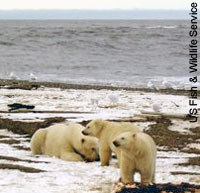
| Polar Bears Shifting Habitat Use | 20 January 10 |
 A long-term study showing changes in polar bears habitat in the southern Beaufort Sea has implications for polar bear management in Alaska, and Canada. A long-term study showing changes in polar bears habitat in the southern Beaufort Sea has implications for polar bear management in Alaska, and Canada.Data collected between 1979 and 2005 shows in autumn polar bears are occurring more frequently on land and open water and less frequently on ice. This results in increased chances of human/bear interaction. "Our results do suggest that bears that use the nearshore area are more likely to occur on land in recent years because their preferred habitat, sea ice, is unavailable," states Karyn Rode, polar bear biologist with the U.S. Fish and Wildlife and co-author of the study. "This is one of the few data sets available over such a long time frame. It shows there has been a shift in habitat use." This work highlights the need to develop programs to manage bear-human interactions in coastal areas. Bear-human interactions in communities and industrial areas in Alaska have been on the rise in recent years. This study will be looked at closely by Canadian scientists concerned with polar bear survival. View January 7, 2010 Science Daily articleView January 7, 2010 Biology News Net article View January 11, 2010 Metro News article Source: Science Daily |
|
 Print version Print version |
Top |
